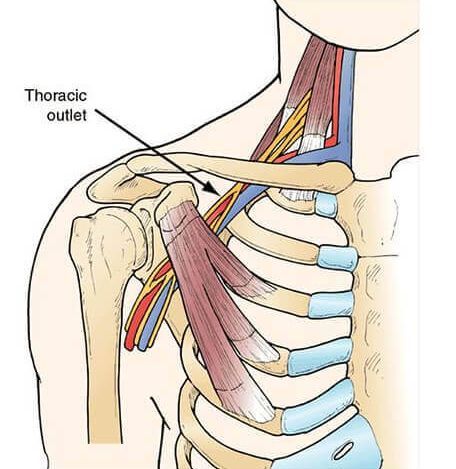You can sit or stand for this test. First, raise both arms with both elbows slightly behind your head. Next, open and close your hands slowly for 3 minutes. A positive sign for thoracic outlet syndrome is pain, numbness, heaviness or weakness in one or both arms. Also, you may feel tingling in one or both hands.
Thoracic Outlet Syndrome Symptoms
From Dr. Z - Carpal tunnel syndrome specialist
Test Yourself for Thoracic Outlet Syndrome
If you have thoracic outlet syndrome symptoms (see below), these 5 tests can quickly verify this condition. They're the same tests your doctor uses in the office.
Now you can perform them at home. If you have thoracic outlet syndrome, you should get started on treatment right away in order to keep it from worsening.
FIND OUT: Do you have carpal tunnel?
Complimentary self-test
What is thoracic outlet syndrome?
Over 1 in 50 people in the USA have thoracic outlet syndrome. That's about the same prevalence as skin cancer.
Generally, thoracic outlet syndrome occurs due to compression in the space between your collarbone and first rib. The compression can be on blood vessels or nerves.
When compression pushes on nerves and blood vessels, you have pain, numbness, weakness and other symptoms. Symptoms can occur anywhere from your fingers to your neck. Often, many patients (and doctors) confuse thoracic outlet syndrome symptoms with those of carpal tunnel syndrome.
Actually, thoracic outlet syndrome it is not one single disorder. Rather, it's a group of disorders that happen due to compression in the
brachial plexus or
thoracic outlet. Therefore, you can have one of three types:
- Neurological thoracic outlet syndrome, which is caused by a nerve compression in the
brachial plexus.
- Vascular thoracic outlet syndrome, which has a blood vessel cause.
- Nonspecific thoracic outlet syndrome, where the cause is unknown.
Compression in these areas causes local nerves or blood vessels to compress. As a result, symptoms vary according to which structures are under compression. For example, a compressed nerve results in symptoms that are different than those caused by a compressed blood vessel.
Usually, physical trauma is the main cause of thoracic outlet syndrome. For instance, it’s common for patients to have it following a car accident, sports injury, repetitive strain injury, and pregnancy. As a matter of fact, many times doctors cannot determine the exact cause of a patient’s thoracic outlet syndrome symptoms whatsoever.
The most common treatment for this condition is physical therapy. In addition, pain relief measures can help ease severe symptoms. Usually, most people will improve using these methods. However, there are cases where doctors recommend surgery to relieve the compression causing it.
Thoracic outlet syndrome symptoms & signs
Thoracic outlet syndrome symptoms due to nerves
Thoracic outlet syndrome symptoms due to compressed nerves (neurological thoracic outlet syndrome) are:
- Muscle wasting in the thick fleshy base of the thumb (thenar eminence)
- Numbness or tingling ("pins & needles") in the fingers or arm
- Aches or pain in the hand, shoulder or neck
- Loss of grip strength

Thoracic outlet syndrome symptoms due to blood vessels
Thoracic outlet syndrome due to compressed blood vessels (vascular thoracic outlet syndrome) are:
- Discoloration of your hand (can be bluish in color)
- Pain or swelling in the arm; can be due to blood clots
- Blood clot in arteries or veins in your upper body
- No color in one or more fingers; sometimes the entire hand
- Weak pulse (or none at all) in the suspected arm
- Fingers, hands or arms are cold
- Your arm fatigues with most activities
- Fingers are numb or tingly
- Arm or neck is weak
- A lump near your collarbone that throbs

5 tests for thoracic outlet syndrome
If you have any of the above thoracic outlet syndrome symptoms, then take the 5 tests below to verify the condition. These are the identical tests for thoracic outlet syndrome that your doctor would perform on you in the office.
You need a willing partner to help do these tests. Each test aims to reproduce the symptoms by further compressing the brachial plexus or the thoracic outlet.
For these tests you must:
- Use a quiet room with no distractions
- Get a willing partner
- Have a chair without arm rests
- Review the instructions & pictures below before attempting the tests
If any one of the following 5 tests for thoracic outlet syndrome is positive, it’s likely you have this condition.
But if they're negative, then you may have carpal tunnel syndrome. In fact, the most common carpal tunnel symptoms are nearly identical to thoracic outlet syndrome symptoms.











